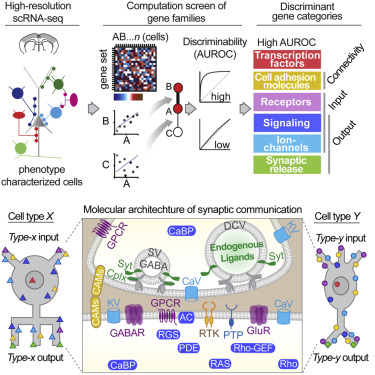Our official English website, www.x-mol.net, welcomes your
feedback! (Note: you will need to create a separate account there.)
Transcriptional Architecture of Synaptic Communication Delineates GABAergic Neuron Identity.
Cell ( IF 45.5 ) Pub Date : 2017-Oct-19 , DOI: 10.1016/j.cell.2017.08.032 Anirban Paul , Megan Crow , Ricardo Raudales , Miao He , Jesse Gillis , Z. Josh Huang
Cell ( IF 45.5 ) Pub Date : 2017-Oct-19 , DOI: 10.1016/j.cell.2017.08.032 Anirban Paul , Megan Crow , Ricardo Raudales , Miao He , Jesse Gillis , Z. Josh Huang

|
Understanding the organizational logic of neural circuits requires deciphering the biological basis of neuronal diversity and identity, but there is no consensus on how neuron types should be defined. We analyzed single-cell transcriptomes of a set of anatomically and physiologically characterized cortical GABAergic neurons and conducted a computational genomic screen for transcriptional profiles that distinguish them from one another. We discovered that cardinal GABAergic neuron types are delineated by a transcriptional architecture that encodes their synaptic communication patterns. This architecture comprises 6 categories of ∼40 gene families, including cell-adhesion molecules, transmitter-modulator receptors, ion channels, signaling proteins, neuropeptides and vesicular release components, and transcription factors. Combinatorial expression of select members across families shapes a multi-layered molecular scaffold along the cell membrane that may customize synaptic connectivity patterns and input-output signaling properties. This molecular genetic framework of neuronal identity integrates cell phenotypes along multiple axes and provides a foundation for discovering and classifying neuron types.
中文翻译:

突触通讯的转录体系结构描述了GABA能神经元身份。
了解神经回路的组织逻辑需要破译神经元多样性和同一性的生物学基础,但是在如何定义神经元类型方面尚无共识。我们分析了一组解剖上和生理上表征的皮质GABA能神经元的单细胞转录组,并对转录谱进行了计算基因组筛选,以将它们彼此区分开。我们发现,主要的GABA能神经元类型由编码其突触通讯模式的转录体系来描述。这种结构包括6个大约40个基因家族,包括细胞粘附分子,递质-调节剂受体,离子通道,信号蛋白,神经肽和囊泡释放成分以及转录因子。跨家族的选择成员的组合表达沿着细胞膜形成了多层分子支架,可以定制突触连接模式和输入输出信号传递特性。这种神经元身份的分子遗传框架整合了沿多个轴的细胞表型,并为发现和分类神经元类型提供了基础。
更新日期:2017-09-21
中文翻译:

突触通讯的转录体系结构描述了GABA能神经元身份。
了解神经回路的组织逻辑需要破译神经元多样性和同一性的生物学基础,但是在如何定义神经元类型方面尚无共识。我们分析了一组解剖上和生理上表征的皮质GABA能神经元的单细胞转录组,并对转录谱进行了计算基因组筛选,以将它们彼此区分开。我们发现,主要的GABA能神经元类型由编码其突触通讯模式的转录体系来描述。这种结构包括6个大约40个基因家族,包括细胞粘附分子,递质-调节剂受体,离子通道,信号蛋白,神经肽和囊泡释放成分以及转录因子。跨家族的选择成员的组合表达沿着细胞膜形成了多层分子支架,可以定制突触连接模式和输入输出信号传递特性。这种神经元身份的分子遗传框架整合了沿多个轴的细胞表型,并为发现和分类神经元类型提供了基础。











































 京公网安备 11010802027423号
京公网安备 11010802027423号